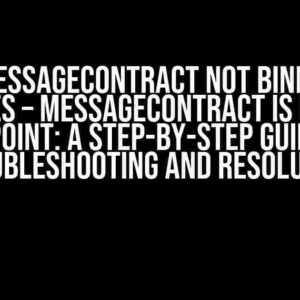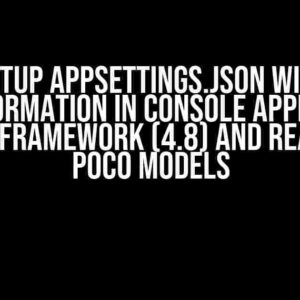Are you tired of struggling to work with XML columns in your SQL Server database using .NET? Do you find yourself Lost in Translation, trying to convert XML data into a usable format? Fear not, dear developer! In this article, we’ll demystify the process of accessing and manipulating SQL Server XML columns using SqlDataReader, and show you how to harness their full potential in your .NET applications.
What is an SQL Server XML Column?
In SQL Server, an XML column is a data type that allows you to store and query XML data directly in your database. This powerful feature enables you to work with hierarchically structured data, such as configuration files, documents, and data feeds, in a flexible and efficient manner. However, when it comes to accessing and processing this data in .NET, things can get tricky.
The Challenge: Converting XML to a String
One of the most common challenges developers face when working with SQL Server XML columns is converting the XML data into a usable string format. By default, SqlDataReader returns XML data as a System.Data.SqlTypes.SqlXml object, which can be cumbersome to work with.
The good news is that there are several ways to convert this object into a string, and we’ll explore each of them in detail. But before we dive in, let’s set the stage with a simple example.
<table>
<tr>
<td><b>ID</b></td>
<td><b>XMLData</b></td>
</tr>
<tr>
<td>1</td>
<td><root><person><name>John</name></person></root></td>
</tr>
<tr>
<td>2</td>
<td><root><person><name>Jane</name></person></root></td>
</tr>
</table>
In this example, we have a table with two columns: ID and XMLData. The XMLData column contains XML data in the form of a string. Our goal is to retrieve this data using SqlDataReader and convert it into a usable string format.
Method 1: Using the XmlReader Class
One way to convert the SqlXml object to a string is by using the XmlReader class. This approach is useful when you need to read large amounts of XML data and want to avoid loading the entire dataset into memory.
using System.Data;
using System.Data.SqlClient;
using System.Xml;
// Create a connection to the database
using (SqlConnection connection = new SqlConnection("Data Source=myServer;Initial Catalog=myDatabase;User ID=myUser;Password=myPassword;"))
{
connection.Open();
// Create a command to retrieve the XML data
using (SqlCommand command = new SqlCommand("SELECT XMLData FROM myTable", connection))
{
using (SqlDataReader reader = command.ExecuteReader())
{
while (reader.Read())
{
// Get the XML data as a SqlXml object
SqlXml xmlData = reader.GetSqlXml(1);
// Create an XmlReader to read the XML data
XmlReader xmlReader = xmlData.CreateReader();
// Read the XML data into a string
StringBuilder xmlString = new StringBuilder();
while (xmlReader.Read())
{
xmlString.Append(xmlReader.ReadOuterXml());
}
// Print the XML data as a string
Console.WriteLine(xmlString.ToString());
}
}
}
}
In this example, we use the XmlReader class to read the XML data from the SqlXml object. We then use a StringBuilder to concatenate the XML data into a single string.
Method 2: Using the ToString() Method
A simpler way to convert the SqlXml object to a string is by using the ToString() method. This approach is useful when you need to quickly retrieve small amounts of XML data.
using System.Data;
using System.Data.SqlClient;
// Create a connection to the database
using (SqlConnection connection = new SqlConnection("Data Source=myServer;Initial Catalog=myDatabase;User ID=myUser;Password=myPassword;"))
{
connection.Open();
// Create a command to retrieve the XML data
using (SqlCommand command = new SqlCommand("SELECT XMLData FROM myTable", connection))
{
using (SqlDataReader reader = command.ExecuteReader())
{
while (reader.Read())
{
// Get the XML data as a SqlXml object
SqlXml xmlData = reader.GetSqlXml(1);
// Convert the XML data to a string using ToString()
string xmlString = xmlData.ToString();
// Print the XML data as a string
Console.WriteLine(xmlString);
}
}
}
}
In this example, we use the ToString() method to convert the SqlXml object directly to a string.
Method 3: Using XDocument and LINQ to XML
Another way to convert the SqlXml object to a string is by using XDocument and LINQ to XML. This approach is useful when you need to work with complex XML structures and want to take advantage of LINQ’s querying capabilities.
using System.Data;
using System.Data.SqlClient;
using System.Xml.Linq;
// Create a connection to the database
using (SqlConnection connection = new SqlConnection("Data Source=myServer;Initial Catalog=myDatabase;User ID=myUser;Password=myPassword;"))
{
connection.Open();
// Create a command to retrieve the XML data
using (SqlCommand command = new SqlCommand("SELECT XMLData FROM myTable", connection))
{
using (SqlDataReader reader = command.ExecuteReader())
{
while (reader.Read())
{
// Get the XML data as a SqlXml object
SqlXml xmlData = reader.GetSqlXml(1);
// Create an XDocument from the XML data
XDocument xdoc = XDocument.Parse(xmlData.Value);
// Convert the XDocument to a string
string xmlString = xdoc.ToString(SaveOptions.DisableFormatting);
// Print the XML data as a string
Console.WriteLine(xmlString);
}
}
}
}
In this example, we use XDocument.Parse() to convert the SqlXml object to an XDocument. We then use the ToString() method to convert the XDocument to a string.
Best Practices and Performance Considerations
When working with SQL Server XML columns and SqlDataReader, there are several best practices and performance considerations to keep in mind:
- Use the correct data type: Make sure to use the correct data type when retrieving XML data from the database. Using the wrong data type can lead to performance issues and data corruption.
- Use streaming data: When working with large amounts of XML data, use streaming data to avoid loading the entire dataset into memory.
- Use caching: Consider caching frequently accessed XML data to improve performance and reduce database load.
- Optimize your database: Make sure to optimize your database schema and indexing strategy for working with XML data.
- Monitor performance: Monitor your application’s performance and adjust your approach as needed to ensure optimal performance.
Conclusion
In conclusion, working with SQL Server XML columns in .NET using SqlDataReader can be a breeze if you know the right techniques. By using the XmlReader class, ToString() method, or XDocument and LINQ to XML, you can efficiently convert XML data to a usable string format. Remember to follow best practices and performance considerations to ensure optimal performance in your applications.
So the next time you find yourself facing the challenge of working with XML columns in SQL Server, don’t get lost in translation. Instead, use the techniques outlined in this article to unlock the full potential of your XML data and take your .NET applications to the next level!
References:
For more information on working with SQL Server XML columns and SqlDataReader, refer to the following resources:
- Microsoft Docs: XML Data Type and Columns (SQL Server)
- Microsoft Docs: SqlXml Class
- Stack Overflow: How to read XML from SQL Server XML data type in C#?
Frequently Asked Question
The wonders of SQL Server and .NET! Where the world of database meets the world of code. But, what happens when we encounter an XML column in SQL Server and we need to access it in .NET using SqlDataReader? Let’s dive in and find out!
Q: What is the data type of an XML column in SQL Server when retrieved using SqlDataReader in .NET?
The data type of an XML column in SQL Server when retrieved using SqlDataReader in .NET is a string. That’s right, when you use SqlDataReader to read an XML column, it’s returned as a string, not as an XmlData type. So, get ready to parse that string into an XML object if you need to!
Q: Can I use SqlDataReader.GetSqlXml() to retrieve an XML column?
Nope! SqlDataReader.GetSqlXml() is used to retrieve a SqlXml object, which is not the same as the XML data type in SQL Server. When you use SqlDataReader.GetSqlXml() on an XML column, you’ll get an InvalidCastException. Instead, use SqlDataReader.GetString() to retrieve the XML column as a string.
Q: How do I parse the string returned by SqlDataReader into an XmlData object?
Easy peasy! You can use the XmlDataDocument class in .NET to parse the string into an XmlData object. Simply create a new XmlDataDocument and load the XML string using the LoadXml() method. Now you can access the XML data using the XmlDataDocument object.
Q: Can I use LINQ to XML to parse the XML string?
Absolutely! LINQ to XML is a great way to parse the XML string and access the XML data in a more concise and expressive way. Simply use the XDocument.Parse() method to parse the XML string and then use LINQ to XML to query and access the XML data.
Q: Are there any performance considerations when working with XML columns in SQL Server and .NET?
You bet! When working with XML columns, especially large ones, performance can be a concern. Consider using XmlReader instead of XmlDataDocument or LINQ to XML to improve performance. Additionally, make sure to index your XML columns in SQL Server and optimize your queries for better performance.



